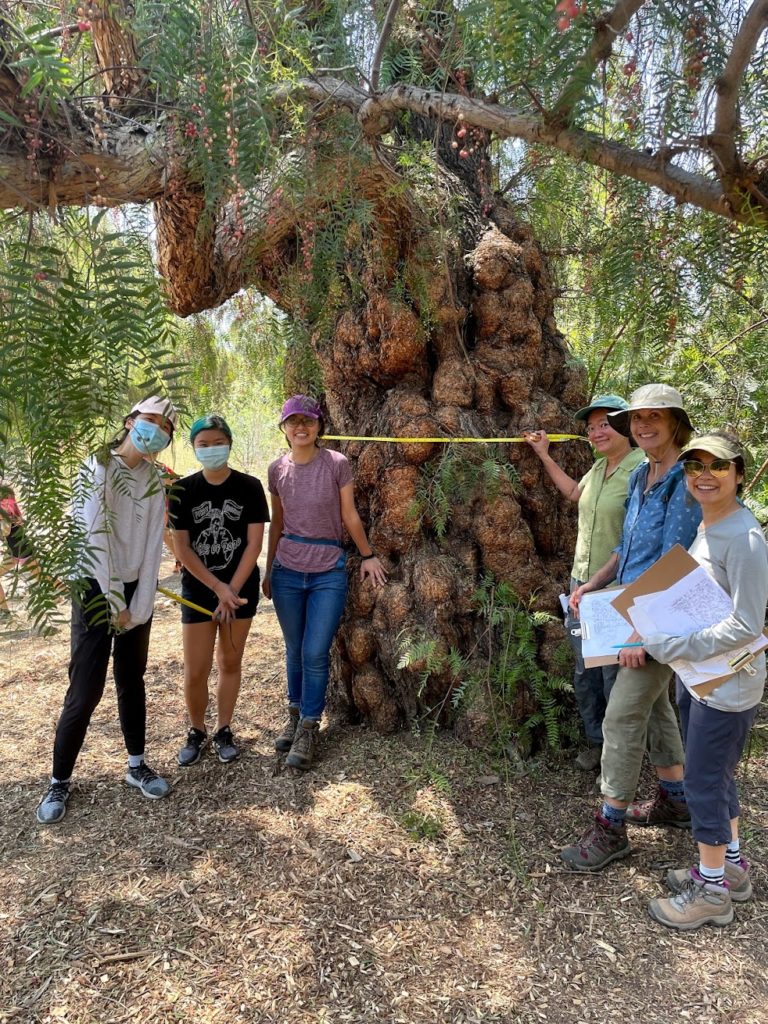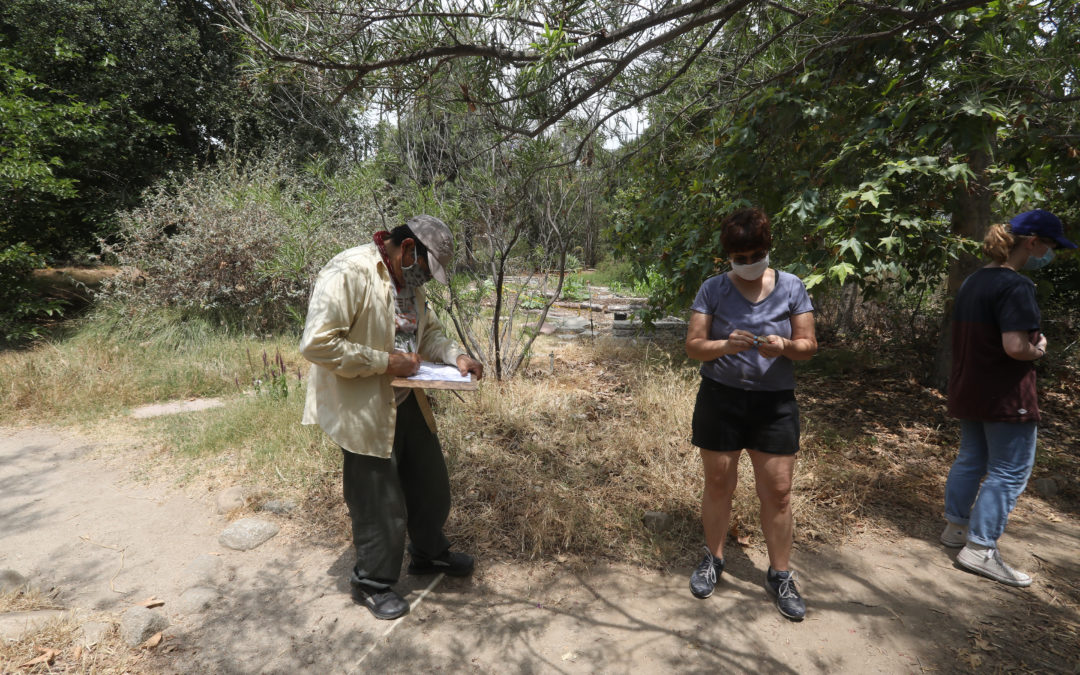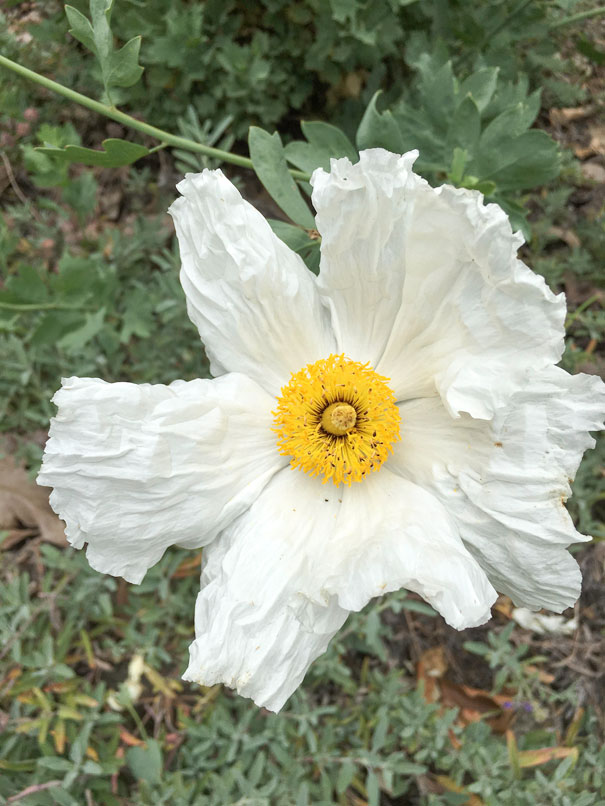by William Hallstrom (Arlington Garden volunteer)
For the past few months, most of the volunteer crew at Arlington Garden have spent at least some of their time wrapping the trunks of each of the garden’s trees with the kind of soft tape measure you might use for sewing, looking up to the highest branches and pacing underneath them while jotting down notes. It’s all part of the tree survey, one of the recent volunteer projects at the garden, whose goal is to determine how much carbon is being sequestered by the trees in Arlington Garden.
Arlington Garden Communications & Volunteer Manager Andrew Jewell says the idea for the tree survey began from a need for some real data to help bolster a proposal. “We set out to quantify the effect the garden has on various environmental measures including atmospheric carbon, the urban heat island effect, rainwater capture,” he says. This would require human effort, which was facilitated by the growth of the volunteer program in recent months.
Arborist Jonathan Flournoy came out to the garden on Tuesday, June 21nd and walked us through the basic process. It’s pretty simple. Teams of volunteers are assigned parts of the garden to work in. Teams of two people work well—one person can take measurements and the other can record them.
Each team is equipped with a map on a clipboard and a pencil, a measuring tape, as well as a piece of chalk. The first task is to identify the tree and match it to one on the map. Then the circumference of the trunk at a height of about 4 1/2 feet from the base is measured and the height of the tree is estimated. Some of the trees are newer and don’t appear on the map, in which case a new record is made. Volunteers used apps like iNaturalist, as well, to help in identifying the trees. The information from the individual survey maps will be added to a master list. After a tree is logged, it is marked with chalk.
While it is pretty straightforward, Flournoy helped us through some of the hiccups. What is the difference between a small tree and a large shrub? What if a tree has multiple trunks? Do we count the snags—trees that have died but are still standing—and how much do those contribute to carbon sequestration? We learned a lot, and many of the volunteers are now knowledgeable enough to lead similar events.
 Flournoy also explained some of the science involved. He says that the data being collected will be used to calculate carbon sequestration based on formulas that will use all of the specific attributes measured. Trees, of course, are carbon-capturing systems. Photosynthesis is a complex process, but more or less, it entails using the energy from sunlight to combine carbon dioxide and water, which is turned into sugars and oxygen. Flournoy says that in trees, “the sugars are converted into cellulose and lignin which are chains of sugars that are very stable and can be difficult to digest.” So trees are built out of this tough material, much of which is made up of carbon, that is absorbed out of the atmosphere and which we call “wood.”
Flournoy also explained some of the science involved. He says that the data being collected will be used to calculate carbon sequestration based on formulas that will use all of the specific attributes measured. Trees, of course, are carbon-capturing systems. Photosynthesis is a complex process, but more or less, it entails using the energy from sunlight to combine carbon dioxide and water, which is turned into sugars and oxygen. Flournoy says that in trees, “the sugars are converted into cellulose and lignin which are chains of sugars that are very stable and can be difficult to digest.” So trees are built out of this tough material, much of which is made up of carbon, that is absorbed out of the atmosphere and which we call “wood.”
When we look at trees, in a way we are looking at carbon in a very durable form. Of all the many kinds of plants, trees, with their typically large mass of woody material, are among the slowest to decompose.
Growing a mature tree takes time, though, at least 10 – 40 years typically, but it could be longer. That is why it is so important to preserve our existing urban trees. When we cut down a perfectly healthy tree in the prime of its life, we are also jump-starting the process of decay, which will quickly negate all of the ecological services that have been accumulating over many years.
Jewell says of the project, “Arlington Garden definitely mitigates some of the urban heat island effect and captures carbon dioxide from the atmosphere — but how much difference are we making?” The tree survey is one step in trying to provide an answer to this question. He says we can try to expand that model, thinking about what could happen if we apply regenerative and sustainable practices of the kinds implemented at Arlington Garden to residential properties, cities, or even entire regions.
He adds that, “by better understanding the ways in which Arlington Garden impacts the environment, we can better educate our visitors about the benefits of regenerative gardening,” as well as having metrics that will be useful to our community and stakeholders.




Recent Comments